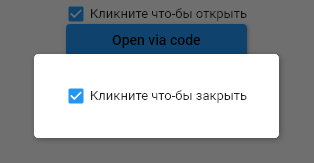Avalonia DialogHost control that provides a simple way to display a dialog with information or prompt the user when information is required.
Dialogs in Avalonia have always been somewhat tricky. This implementation is designed to:
- Provide correct styling
- Allow any dialog to be constructed
- Compatible with code-behind
- Compatible with MVVM
- Compatible with pure XAML
- Work in applications with multiple windows
Dialogs are asynchronous so at some point you will have to deal with that in your code.
- Install
DialogHost.Avalonianuget package - Add DialogHost styles to your app in
App.xaml. See the example ofApp.xaml:
<Application ...>
...
<Application.Styles>
...
<!-- This line \/ required -->
<StyleInclude Source="avares://DialogHost.Avalonia/Styles.xaml"/>
<!-- This line /\ required -->
</Application.Styles>
...
</Application>- Start using control
The cornerstone of dialogs the DialogHost control. It’s a content control, meaning the underlying content over which the popup dialog will be displayed can be targeted; to a specific area of your app, or the entire Window content.
<Window ...
xmlns:dialogHost="clr-namespace:DialogHost;assembly=DialogHost.Avalonia"
...
Title="DialogHost.Demo">
<dialogHost:DialogHost CloseOnClickAway="True">
<dialogHost:DialogHost.DialogContent>
<!-- put your dialog content here-->
</dialogHost:DialogHost.DialogContent>
<!-- put the content over which the dialog is shown here (e.g. your main window grid)-->
</dialogHost:DialogHost>
</Window>When the dialog is open, the underlying content will be dimmed and disabled.
DialogHost.DialogContent (associated with DialogHost.DialogContentTemplate) is your typical XAML content object
property for setting the content of your dialog. You can infer from this that you can use MVVM to bind content, but
there are multiple ways of populating the content, showing the dialog, closing the dialog, and processing responses.
Command="{Binding RelativeSource={RelativeSource FindAncestor, AncestorType=materialDesign:DialogHost}, Path=OpenDialogCommand}"ICommand, typically used on buttons, where DialogContent can be set via CommandParameter.
<dialogHost:DialogHost IsOpen="True" />Dependency property, to be triggered from XAML, set from code-behind or via a binding. Content must be set in DialogHost.DialogContent.
DialogHost.Show(viewOrModel);Async/await based static API which can be used purely in code (for example from in a view model). Content can be passed
directly to the dialog. Note that if you have multiple windows and multiple DialogHost instances you can set
the DialogHost.Identifier property, and provide the identifier to the .Show(...) method to help find the required
DialogHost.
You can bind to the DialogHost's OpenDialogCommand:
Command="{Binding RelativeSource={RelativeSource FindAncestor, AncestorType=materialDesign:DialogHost}, Path=CloseDialogCommand}"ICommand, typically used on buttons inside the dialog, where the command parameter will be passed along to the dialog response.
<dialogHost:DialogHost IsOpen="False" />Dependency property, to be triggered from XAML, set from code-behind or via a binding.
Via any of the methods for handling the opened event, you can get hold of the dialog session. This can be used to close a dialog via code:
var result = await DialogHost.Show(myContent, delegate(object sender, DialogOpenedEventArgs args)
{
args.Session.Close(false);
});or getting DialogSession
DialogHost.GetDialogSession("DialogHost.Identifier here")?.Close(false);The DialogClosingEventHandler delegate is key. It provides the parameter provided to DialogHost.CloseDialogCommand, and allows the pending close to be cancelled.
The following mechanisms allow handling of this event, via code-behind, MVVM practices, or just from the code API:
<dialogHost:DialogHost DialogClosing="DialogHost_OnDialogClosing" />Bubbling RoutedEvent, which could be used in code-behind.
<dialogHost:DialogHost DialogClosingCallback="{Binding DialogClosingHandler}" />Standard dependency property which enables the DialogClosingEventHandler implementation to be bound, typically from a view model.
var result = await DialogHost.Show(viewOrModel, ClosingEventHandler);The async response from this method returns the parameter provided when DialogHost.CloseDialogCommand was executed. As
part of the Show() signature a DialogClosingEventHandler delegate can be provided to intercept the on-closing event,
just prior to the close.

